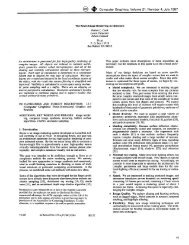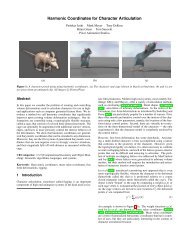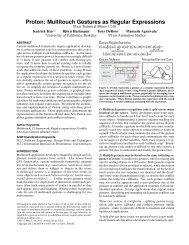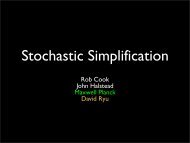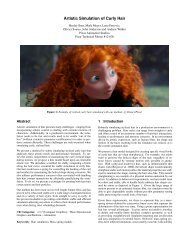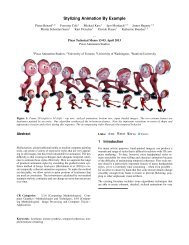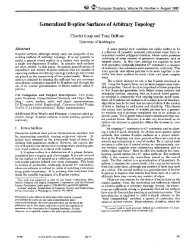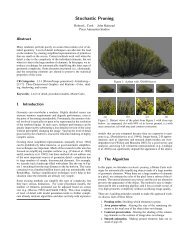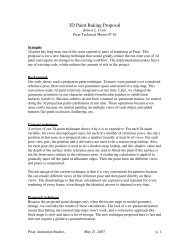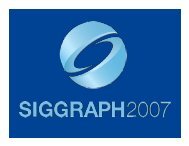Correlated Multi-Jittered Sampling - Pixar Graphics Technologies
Correlated Multi-Jittered Sampling - Pixar Graphics Technologies
Correlated Multi-Jittered Sampling - Pixar Graphics Technologies
Create successful ePaper yourself
Turn your PDF publications into a flip-book with our unique Google optimized e-Paper software.
subregion of the full pattern. If the ordering is not wanted, an additional permutation<br />
step on s can be added to decorrelate corresponding samples from<br />
dierent patterns.<br />
With a small variation, we can also easily implement the stretching and<br />
clipping method previously described for handling irregular N. The following<br />
modies the previous function to compute a suitable m and n with aspect ratio<br />
a and apply the stretch and clip. It also shues the samples’ order:<br />
Listing 6: The nal sampling code.<br />
xy cmj(int s, int N, int p, float a = 1.0f) {<br />
int m = static_cast(sqrtf(N * a));<br />
int n = (N + m - 1) / m;<br />
s = permute(s, N, p * 0x51633e2d);<br />
int sx = permute(s % m, m, p * 0x68bc21eb);<br />
int sy = permute(s / m, n, p * 0x02e5be93);<br />
float jx = randfloat(s, p * 0x967a889b);<br />
float jy = randfloat(s, p * 0x368cc8b7);<br />
xy r = {(sx + (sy + jx) / n) / m,<br />
<br />
(s + jy) / N};<br />
return r;<br />
}<br />
Finally, note that though the code shown here is aimed at conciseness rather<br />
than speed, most C++ compilers do a good job of optimizing it by moving invariants<br />
out of the loop when computing a pattern’s worth of samples at a<br />
time; we can get 16.9M samples/s on a single 2.8GHz Xeon X5660 core with<br />
ICC 12.1. Computing a single sample at a time (as for path tracing), however,<br />
tends to defeat this and force recomputation of the invariants. Manually creating<br />
a small thread-local single-item cache that recomputes the permutation<br />
masks and multiplicative inverses only when N truly does change can provide<br />
a signicant speed improvement.<br />
Conclusion<br />
We have presented a modication to jittering and multi-jittering that greatly<br />
reduces the noise in rendered images at higher sample counts while gracefully<br />
degrading to unstructured noise at low sample counts. The provided implementation<br />
is well suited for parallel environments: it produces repeatable samples,<br />
is exible with respect to sample ordering, and allows for ecient sampling<br />
from subregions of a full pattern. It will be the foundation for stratied<br />
sampling in <strong>Pixar</strong>’s RenderMan Pro Server begining with version 18.0.<br />
While the focus of this work has been on 2D, the functions permute()<br />
and randfloat() can trivially be used for shued 1D jittered sampling as<br />
well. The ease of shuing makes generating higher dimensional samples from<br />
combinations of 1D and 2D samples quite straightforward. Nonetheless, we<br />
are currently exploring generalizations of the algorithm to 3D and above.<br />
Other areas for future work include modifying the shuing of the samples’<br />
order to visit well-spaced samples rst. This would make the sample sequence<br />
hierarchical and improve the initial feedback in progressive rendering.<br />
We would also like to consider spatially-varying sample densities, arbitrary dimensional<br />
samples (for paths), and mapping sample patterns over entire images<br />
rather than individual pixels.<br />
The author wishes to thank the members of the RenderMan team for their<br />
help on this project, especially Per Christensen who commented on early dras<br />
of this paper. Leonhard Grünschloß of Weta also provided helpful comments.<br />
8



